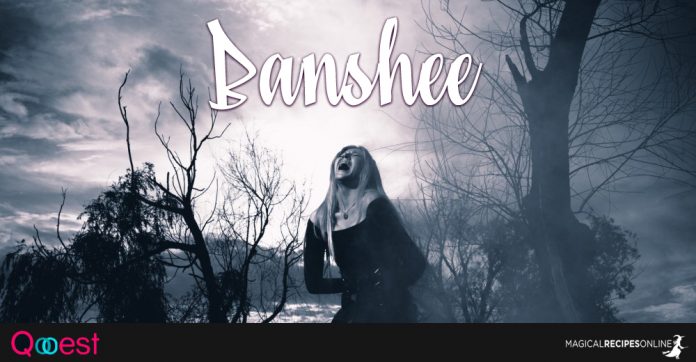The Lore of the Banshee:
The name of this Celtic creature is very well known, and very much feared. But, I will attempt to restore her name here. For, in fact, a Banshee is – at least most of the times – a good being, and not an evil one.
The name itself is Celtic. She most usually appears in Scotland and Ireland, although similar creatures, with other names, appear in many cultures. The etymology and the exact meaning of the name varies, depending on which Celtic language gave birth to it. The meaning can be as simple as, a female fairy, to, the one who washes the clothes of the dead.
Basically, the Banshee is a fairy. Some stories, claim for her to be the ghost of a woman. In some cases, even of a specific woman. But I believe that these are not real Banshees.
Thus, a Banshee is a female fairy who cries and mourns for the death of a mortal. In some cases, she is seen to wash the armours of dead soldiers, or to wash the clothes of the dead.
The Banshee and the dead:
Some say that a Banshee appears only upon the death of an important person. Others say that this is not true. Some believe that there is a connection between some Banshees and some particular families. There are several Scottish and Irish families that claim to have Banshees attached to them.
Originally, the Banshee doesn’t seem to predict the coming death of somebody. She just mourns when it happens. But Banshees seem to appear to, or at least be heard by, the family members of the dead, even when the person died elsewhere. Even more, regardless if the family members know about the death, or not. So, the Banshee is capable of farseeing the death, and not foreseeing it. But the “far” became “fore” easily, and the Banshee became the omen of an upcoming death.
Anyway, even if the Banshee can foresee the death, she has no power over it. The Banshee does not kill anyone. She does not decide if and when somebody will die. She just cries for the lost of somebody. In some stories, she even tries to advise a person to change his course of actions, in order to avoid death.
The Forms of the Banshee:
The forms of the Banshees are many. She can appear as young and beautiful, as an old hug, as monstrous. The same goes for her weeping. Some say that it is soft and divinely pleasant, some say it is like an awful shriek and some even say that glasses break when a Banshee cries. It is worth mentioning that some describe the sound of the Banshee to be similar to the cry of the Owl, another typical omen of death.
So the Banshee can appear as a woman of any beauty and age she sees fit for the occasion and may express her sorrow by any kind of wail she also finds appropriate. In any case though, she seems to care about the death, and she seems to feel sorrow about it.
The Origins of the Banshee:
Some would find the first Banshee in the Fury Alecto (Αληκτώ), but this would explain only the shrieking hag, and not the crying, fair maiden, that washes the clothes of the dead. Also Alecto would scream out of anger, and not out of sorrow. There is also one more path that leads to the three Furies, and I am going to come to it in a while. Still there are enough evidence to conclude that the Furies have nothing to do with the Banshee.
Now, back to the Celts, it seems that the Banshee may come from the Morrigan. The name can mean Phantom Queen, Queen of Phantoms, Great Queen, or Queen of Nightmares, depending on what etymology we are going to give to it.
Morrigan can be a Goddess, or goddess-like creature. Also, she can appear as three Goddesses, or goddess-like creatures. In that case, the three of them would be sisters. And this is the other path that can lead to the Furies.
Morrigan is a Goddess (or as explained before) of battle and, maybe, nobility. Now, this would explain the fact that Banshees most usually appear when deaths happen in battles. Also, it would explain the rare occasions that Banshees sung their songs, and not their wails, to honour the crowning of kings.
Now, Morrigan is Irish and not Welsh. In the Welsh language the mor would refer to the sea. But the assumption that the name refers to a creature of the sea would explain the later confusion between the stories that give to the banshees many of the attitudes of the mermaids.
Grasping the opportunity, I would like to say here that the Welsh, well known, Morgan(a) le Faye, who by some is considered to be Morrigan, is in fact improbable to be her. But we can see in Morgana’s magic the use of the water element, as the “mor” suggests.
Morrigan and Lamia:
Since Morrigan doesn’t seem to be in the original Irish Pantheon, I wonder where she comes from. The only other Goddess that can be one or three, she is called upon as Great Queen, she rules ghosts and nightmares, she appears in many animalistic forms (as does Morrigan), her voice can be gentle and pleasant, or furious and terrible, is obviously the Goddess Hecate. So maybe the Celtic Morrigan comes from the Greek Hecate.
In early Christian years, Morrigan was connected with Lilith. Even more, Lilith was associated to the Greek Lamia (Λάμια). Although I don’t believe there is any real connection between Lilith and Morrigan, or Lilith and Lamia, and therefore no connection between Morrigan and Lamia, I will analyse this a little more.
Lamia was a very beautiful woman and Zeus (Δίας) fall in love with her. So Hera (Ήρα) cursed Lamia to eat all her own children. Lamia did so, and after eating each of her children, she cried for it. The only child of hers that Hera “saved” for this curse was her daughter Scylla (Σκύλλα). But, Hera saved her, only to curse her to became a monster who would eat the children of the men. And that, of course, refers to any human. This is the same Scylla that Odysseus came across.
Either because Lamia was daughter of Poseidon, or because of Hera’s curse, she became immortal. And because she was very beautiful, after Zeus, she had many men fall in love with her. But the curse was active so, all the children she gave birth to, she devoured them. In some later stories, she even eats the mortals with whom she has the children.
Now, these aspects of Lamia, the ability to seduce men, and eat them, have been added to the aspects of the Banshees. This happens mostly in America rather than in Europe. But I believe that if a so-called banshee indeed did something like that, she most probably was a succubus and not a real banshee. And a succubus is a demon. Not a fairy.
Also, in some later appearances of banshees, they are just bad omens and not really omens of a death. Personally, I believe these appearances are not of banshees either.
Finally, I would like to mention that the belief of the existence of banshees is surely one of the strongest beliefs in supernatural beings. There are many, living people who state they have seen, or heard Banshees. On the other hand, a more scientific opinion says that the banshees are nothing more than the Common Barn Owl and a lot of imagination.
That’s all. Have fun.

